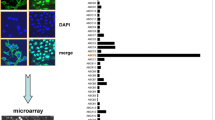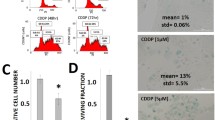Abstract
Glutathione has a variety of important physiological functions in cellular metabolism and defense, including protection from radicals, oxidative stress, and electrophilic compounds. On the basis of this interaction with both endogenous and synthetic substances, glutathione and the key enzyme for its conjugation, glutathioneS-transferase, appear to be critical determinants in tumor cell resistance to several antineoplastic drugs, e.g. platinum analogs. In ten established head and neck cancer cell lines (UM-SCC 10A, 10B, 11B, 14A, 14B, 14C, and 22B, HLac79, 8029NA, and 8029DDP4) chemosensitivity to cisplatin, carboplatin, 5-fluorouracil, and bleomycin, as well as cellular glutathione content and activity of glutathioneS-transferase were determined. The results revealed no correlation between the sensitivity of tumor cells to any of the drugs tested and the level of glutathione or the activity of glutathioneS-transferase. However, the cisplatin-resistant subpopulation 8029DDP4 showed the highest glutathione level and marked cross-resistance to bleomycin. Glutathione depletion with buthionine sulfoximine led to moderately increased sensitivity towards cisplatin and carboplatin in all cell lines, but did not affect their response to 5-fluorouracil or bleomycin. These results suggest that the level of glutathione or the activity of glutathioneS-transferase is not a suitable parameter for the assessment of chemosensitivity in head and neck squamous-cell carcinoma lines. However, response to platinum analogs is influenced by alterations of the initial intracellular glutathione concentration.
Similar content being viewed by others
References
Alley MC, Scudiero DA, Monks A, Hursey ML, Czerwinski MJ, Fine DL, Abbot BJ, Mayo JG, Shoemaker RH, Boyd MR (1988) Feasability of drug screening with panels of human tumor cell lines using a microculture tetrazolium assay. Cancer Res 48: 589–601
Arrick BA, Nathan CF (1984) Glutathione metabolism as a determinant of therapeutic efficacy. Cancer Res 44:4224–4232
Bier H (1991) Circumvention of drug resistance in cisplatin-resistant sublines of the human squamous carcinoma cell line HLac 79 in vitro and in vivo. Acta Otolaryngol 111:797–806
Bier H (1993) Chemotherapeutic drug resistance in the management of head and neck cancer. Eur Arch Otorhinolaryngol 250: 200–208
Bier H, Bergler W, Mickisch G, Wesch H, Ganzer U (1990) Establishment and characterisation of cisplatin-resistant sublines of the human squamous carcinoma cell line HLac 79. Acta Otolaryngol 110:466–473
Carey TE (1985) Establishment of epidermoid carcinoma cell lines. In: Wittes RE (ed) Head and neck cancer. Wiley, Chichester, pp 287–314
Carey TE (1994) Head and neck tumor cell lines. In: Hay RJ (ed) Atlas of human tumor cell lines. Academic Press, San Diego, pp 79–120
Chabner BA (1986) The oncologic end game. J Clin Oncol 4:625–638
Chasseaud LF (1979) The role of glutathione and glutathioneS-transferases in the metabolism of chemical carcinogens and other electrophilic agents. Adv Cancer Res 29:175–274
Gallo JM, Brennan J, Hamilton TC, Halbherr T, Laub PB, Ozols RF, O'Dwyer PJ (1995) Time-dependent pharmacodynamic models in cancer chemotherapy: population pharmacodynamic model for glutathione depletion following modulation by buthionine sulfoximine (BSO) in a phase I trial of melphalan and BSO. Cancer Res 55:4507–4511
Habig WH, Jakoby WB (1981) GluthathioneS-transferase (rat and human). Methods Enzymol 77:218–230
Hafner D, Heinen E, Noack E (1977) Mathematical analysis of concentration-response-relationships: method for the evaluation of the ED50 and the number of receptor binding sites using a logit transformation. Drug Res 27:1871–1873
Hill BT, Deuchars KL, Hosking LK, Ling V, Whelan RD (1990) Overexpression of P-glycoprotein in mammalian tumor cell lines after fractionated irradiation. J Natl Cancer Inst 82:607–612
Ishikawa T, Ali-Osman F (1993) Glutathione-associatedcis-diamminedichloroplatinum(II) metabolism and ATP-dependent efflux from leukemia cells. J Biol Chem 268:1–10
Jacobs C (1991) Adjuvant and neoadjuvant treatment of head and neck cancers. Semin Oncol 18:504–514
Janot F, Massaad L, Ribrag V, Waziers I de, Beaune PH, Luboinski B, Parise O, Gouyette A, Chabot GG (1993) Principal xenobioticmetabolizing enzyme systems in human head and neck squamous cell carcinoma. Carcinogenesis 4:1279–1283
Meister A (1983) Selective modification of glutathione metabolism. Science 220:472–477
Meister A, Anderson ME (1983) Glutathione. Annu Rev Biochem 52:711–760
Mosmann T (1983) Rapid colorimetric assay for cellular growth and survival: application to proliferation and cytotoxicity assays. J Immunol Methods 65:55–63
Mulcahy RT, Tutsch KD, Pomplun M, Arzoomanian RZ, Alberti D, Feierabend C, Bailey HH (1994) The pharmacodynamics ofl-S,R-buthionine-sulfoximine (BSO) given as a 24–48 hour continuous infusion in patients undergoing phase I treatment with i.v. melphalan and BSO. Proc Am Assoc Cancer Res 35:377
Nathan CF, Arrick BA, Murray HW, Santis NM de, Cohn ZA (1980) Tumor cell anti-oxidant defenses. J Exp Med 153:766–782
Orrenius S, Moldeus P (1984) The multiple role of glutathione in drug metabolism. Trends Pharmacol Sci 5:432–435
Ozols RF (1991) Molecular and clinical advances in anticancer drug resistance. Kluwer, Boston
Pinedo HM, Peters GF (1988) Fluorouracil: biochemistry and pharmacology. J Clin Oncol 6:1653–1664
Ripple GH, Mulcahy RT, Tutsch KD, Arzoomanian RZ, Alberti D, Feierabend C, Mahvi D, Schink J, Pomplun M, Wilding G, Bailey HH (1995) Tumor glutathione depletion to<10% of baseline observed during a phase I trial of continuous infusionl-S,R-buthionine sulfoximine. Proc Am Assoc Cancer Res 36:238
Russo A, Mitchell JB, Mc Pherson S, Friedman N (1984) Alteration of bleomycin cytotoxicity by glutathione depletion or elevation. Int J Radiat Oncol Biol Phys 10:1675–1678
Snow GB, Clark JR (1992) Multimodality therapy for head and neck cancer. Thieme, Stuttgart
Talmadge JE, Wohman SR, Fidler IJ (1982) Evidence for the clonal origin of spontaneous metastatis. Science 217:361–363
Teicher BA, Holden SA, Kelley MJ, Shea TC, Cucchi CA, Rosowsky A, Henner WD, Frei E (1987) Characterization of a human squamous carcinoma cell line resistant to cis-diamminedichloroplatinum (II). Cancer Res 47:388–393
Tew KD (1994) Glutathione-associated enzymes in anticancer drug resistance. Cancer Res 54:4313–4320
Tsuruo Z, Fidler IJ (1981) Differences in drug senstivity among tumor cells from parental tumors, selected variants and spontaneous metastases. Cancer Res 41:3058–3064
Zenner HP, Lehner W, Herrmann IF (1979) Establishment of cell lines from larynx and submandibular gland carcinoma. Arch Otorhinolaryngol 225:269–277
Author information
Authors and Affiliations
Rights and permissions
About this article
Cite this article
Bier, H., Hoffmann, T., Eickelmann, P. et al. Chemosensitivity of head and neck squamous carcinoma cell lines is not primarily correlated with glutathione level but is modified by glutathione depletion. J Cancer Res Clin Oncol 122, 653–658 (1996). https://doi.org/10.1007/BF01209027
Received:
Accepted:
Issue Date:
DOI: https://doi.org/10.1007/BF01209027




